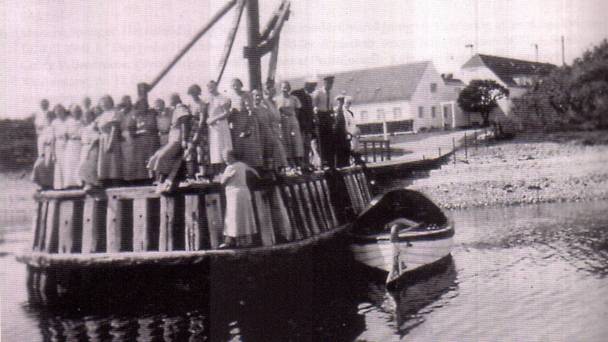Today, the company AS Storebælt owns Sprogø, an island of less than one square kilometre in size, now joined with its neighbour Ny Sprogø by the bridge between Funen and Zealand. No longer isolated by water, its southerly end is closed to the public as a nature reserve, home to rare species of amphibious and plant life. Its purpose less than a lifetime ago was a little more questionable.
Though many of the original buildings of the part prison, part work camp and part psychiatric hospital are still standing, there’s not many traces left of the old institution. The gymnastics hall is now a conference room, the girls’ rooms are offices, and holiday apartments have been built where the old annexes were.
A small room on the first floor, just two metres by two metres, stands empty: despite the repainting job, the large scratch and fist marks are clearly visible on the inside of the door. It was used as a cell in the women’s home, where they were locked up for bad behaviour and could be subdued with belts, straitjackets or an injection – a rare occurrence, but one deemed sometimes necessary.
Scapegoats of society
One of the sadder chapters of modern Danish history, the stories of these forgotten women, has now been acknowledged in a book written by Birgit Kirkebæk, a doctor in special pedagogy, entitled ’Letfærdig og Løsagtig,’ which roughly translates as ‘loose and easy’ and is how the typical Sprogø girl was described in doctors’ notes.
The story of the Kellersk Institute begins in 1923 in a Europe still reeling from World War One and the Russian Revolution, convinced that the very fabric of civilisation was under attack. Unemployment figures had swelled, as had the instances of sexually transmitted disease: ‘loose’ sexual morals were blamed for a myriad of social problems, and there was a focus on sexually active women as the spreaders of disease. The practice of eugenics, which proposed the selection of the fittest and the gradual decline of the genetically weak, came into vogue.
A large reason behind the establishment of the Sprogø colony was to reduce the unhealthy production of children who might have ‘degenerate genes’. The island’s ‘architect’ was Christian Keller, a senior consultant at the Kellersk Institute for the Mentally Deficient, who had previously founded the Lirø Establishment for Inappropriate Men in 1911. Economic reasons were cited for the bid to halt such births – these ’unwanted’ children would otherwise be nothing but a burden on society.
“Morally deficient”
Kirkebæk’s book is based on the doctors’ notes, letters and school reports of 18 Sprogø women, together with newspaper articles, doctor treatments and amendments to the laws of the time. Terms like ‘erotomania’ and ‘hypersexuality’ were often used to send a woman to Sprogø, who were also given an IQ test. Those who scored below 70 were deemed mentally deficient, but although this was supposedly the deciding criteria, according to Kirkebæk, in reality the establishment was more for isolating the ’morally weak’. She writes that most went to an ordinary state school, and even if few of them received exemplary grades, most could at least read and write. “Very few were what we see today as retarded,” she wrote.
The women often came from large, dysfunctional homes where alcoholism and violence flourished. Social problems in a family were often taken as an expression of hereditary defects and used as an argument to intervene. Many of the women were incest survivors – something actually used to strengthen the diagnosis; as a child she had already seduced her relative!
Because of the reputation of the island and its ‘easy women’, it exuded a fascination for the outside world, and it was not uncommon for fishermen to pick up women from the island to have sex with them, often resulting in pregnancies.
Done in ’61
Sprogø was run as a farm, and though the women worked without pay their families received money during their stay. Despite humane intentions to offer women treatment rather than punishment, admittance was indefinite and it was Keller himself who decided when a woman could leave. Two laws in particular affected the women: the Sterilisation Law of 1934, which pretty much made sterilisation a condition of being able to go home, and an amendment to the Marriage Law in 1938, which meant that men and women judged to be mentally deficient were not allowed to marry.
Altogether 500 women were admitted to the Sprogø Institute – usually between 40 and 50 at a time. They were there for various reasons – sometimes they’d run away from home or care, got into trouble with the law, fallen pregnant or simply could not take care of themselves. They remained on the island, on average, for seven years, though one woman languished there for 38 years. Throughout the ’50s, the numbers dwindled until the last Sprogø girl left the island in 1961.
Even before the institute was closed down, it was being considered as a home for young criminals, and Birgit Kirkebæk suggests that the thought of deporting and isolating certain aspects of society remains. “Who is most dangerous now?” she asked. “The idea shows up again and again.”
















